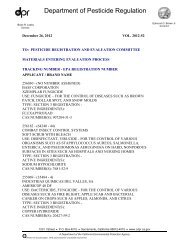Dichlorvos (DDVP) Risk Characterization Document - California ...
Dichlorvos (DDVP) Risk Characterization Document - California ...
Dichlorvos (DDVP) Risk Characterization Document - California ...
You also want an ePaper? Increase the reach of your titles
YUMPU automatically turns print PDFs into web optimized ePapers that Google loves.
Gavage - Rat<br />
In a study conducted by the National Toxicology Program (NTP), F344/N rats (50/sex/group) were<br />
dosed with <strong>DDVP</strong> (99% purity; 0, 4 or 8 mg/kg-day; or 0, 2.9, or 5.7 mg/kg-day adjusted for 5<br />
days/week dosing) in corn oil by gavage for 24 months (Chan, 1989). There was no difference in the<br />
survival rate or body weight gain between the control and treated groups. Mild diarrhea was noted<br />
(frequency and treatment group were not specified) and was considered to be a compound-related<br />
clinical sign. There were dose-related increases in non-oncogenic lesions in the liver (cytoplasmic<br />
vacuolization), and adrenal glands (cortical cytoplasmic vacuolization). However, the effects in the<br />
liver and adrenal glands were considered minor and probably due to the use of corn oil as the vehicle<br />
rather than a direct effect of <strong>DDVP</strong>. Oncogenic effects observed were: increased multiplicity of<br />
pancreatic exocrine cell adenomas in the males and increased numbers of mononuclear cell<br />
leukemias in the males (Table 4). The increased incidences in the treated groups were significant<br />
with respect to pairwise comparison and trend. There were also minor increases, but not dose related<br />
or statistically significant, in the incidences of mammary gland combined tumors (adenomas,<br />
fibroadenomas, and carcinomas) in the females and alveolar/bronchiolar adenomas. This study was<br />
considered acceptable to DPR according to FIFRA guidelines.<br />
Table 4.<br />
The incidences of tumors in rats treated with <strong>DDVP</strong> by gavage for 2 years a<br />
Dosage (mg/kg-day) b<br />
Tumor types 0 2.9 5.7<br />
Pancreatic adenoma, males 16/50 ++ 25/49* 30/50*<br />
(32%) (51%) (60%)<br />
Pancreatic adenoma, females 1/50 1/46 4/50<br />
( 2%) ( 2%) ( 8%)<br />
Mononuclear leukemia, males 11/50 + 20/50* 21/50*<br />
(22%) (40%) (42%)<br />
Mononuclear leukemia, females 17/50 21/48 23/50<br />
(34%) (44%) (46%)<br />
Mammary gland tumors, females<br />
(carcinoma, fibroadenoma, and adenoma) 11/50 20/48* 17/49<br />
(22%) (42%) (35%)<br />
a/<br />
b/<br />
Data were from Chan (1989). Incidences were expressed as the number of animals bearing<br />
tumors per animals at risk. All animals with at least 52 weeks of exposure or alive when the<br />
first tumor was detected, whichever occurs first, were considered at risk. Level of statistical<br />
significance, p @ 0.05 (* or + ) or p @ 0.01 ( ++ ), is indicated after each incidence. Significance at<br />
the control value is based on a dose-weighted chi-square trend test, and significance at the<br />
dosed groups is for the Fisher's Exact Test.<br />
Dosages adjusted for 5 days per week dosing.<br />
32
















